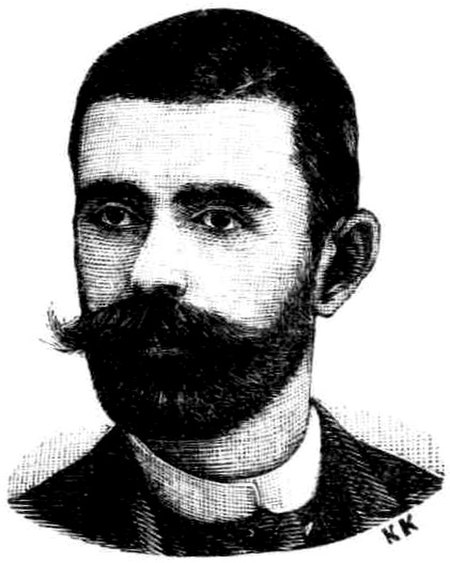Biface
| ||||||||||||||||||||||||||||
Read other articles:

Historic valley in Jerusalem and religious concept This article is about the valley located in Jerusalem, and the biblical term analogous to Christian Hades, Hell or Purgatory. For other uses, see Gehenna (disambiguation). GehennaGehinnomValley of HinnomGehennaLocation in Jerusalem, south of Mount ZionNamingNative nameגיא בן הינום (Hebrew)GeographyCoordinates31°46′6.3″N 35°13′49.6″E / 31.768417°N 35.230444°E / 31.768417; 35.230444 RiversGe…

此條目可能包含不适用或被曲解的引用资料,部分内容的准确性无法被证實。 (2023年1月5日)请协助校核其中的错误以改善这篇条目。详情请参见条目的讨论页。 各国相关 主題列表 索引 国内生产总值 石油储量 国防预算 武装部队(军事) 官方语言 人口統計 人口密度 生育率 出生率 死亡率 自杀率 谋杀率 失业率 储蓄率 识字率 出口额 进口额 煤产量 发电量 监禁率 死刑 国债 外…

密西西比州 哥伦布城市綽號:Possum Town哥伦布位于密西西比州的位置坐标:33°30′06″N 88°24′54″W / 33.501666666667°N 88.415°W / 33.501666666667; -88.415国家 美國州密西西比州县朗兹县始建于1821年政府 • 市长罗伯特·史密斯 (民主党)面积 • 总计22.3 平方英里(57.8 平方公里) • 陸地21.4 平方英里(55.5 平方公里) • �…

تجربة أطلسمعلومات عامةجزء من مصادم الهدرونات الكبير سُمِّي باسم أطلس البلد سويسرا تقع في التقسيم الإداري جنيف الإحداثيات 46°14′08″N 6°03′19″E / 46.235555555556°N 6.0552777777778°E / 46.235555555556; 6.0552777777778 موقع الويب atlas.cern (الإنجليزية) المدونة الرسمية atlas.cern… (الإنجليزية) تعديل - تعديل �…

Questa voce o sezione sull'argomento biochimica non è ancora formattata secondo gli standard. Contribuisci a migliorarla secondo le convenzioni di Wikipedia. Segui i suggerimenti del progetto di riferimento. Argininaformula di struttura Nome IUPACacido 2(S)-ammino-5-guanidilpentanoico AbbreviazioniRARG Nomi alternativiL-arginina acido α-ammino-δ-guanidinvalerianico Caratteristiche generaliFormula bruta o molecolareC6H14N4O2 Massa molecolare (u)174,20 Aspettosolido cristallino biancastro …

1993 puzzle video game 1993 video gameOh My God!Developer(s)AtlusPublisher(s)AtlusPlatform(s)Arcade GameRelease1993Genre(s)Puzzle gameMode(s)Single-player, multiplayer Oh My God! is an arcade puzzle game from Atlus. The gameplay is similar to a cross between Columns and Snake. Gameplay A sequence of snakes made of colored balls fall down into the playing field. The object of the game is to manipulate the direction of these snakes, by using the joystick, in order to form a line of 3 colored balls…

Fleet of merchant vessels that are registered to Canada Canada, like several other Commonwealth nations, created the Canadian Merchant Navy (French: Marine marchande Canadienne) in a large-scale effort during World War II. 184 ships are involved in merchant shipping activity in the Canadian shipping industry. History The 529-foot (161.2 m) Canadian laker James Carruthers on Lake Huron in 1913. An informal merchant navy appeared in 1914 at the start of World War I and was renamed Canadian Go…

Canadian sports executive (1895–1980) This article is about the person. For the trophy, see Conn Smythe Trophy. Conn SmytheBornConstantine Falkland Cary Smythe(1895-02-01)February 1, 1895Toronto, OntarioDiedNovember 18, 1980(1980-11-18) (aged 85)Toronto, OntarioResting placePark Lawn Cemetery, TorontoNationalityCanadianEducationUpper Canada CollegeJarvis Collegiate InstituteUniversity of TorontoOccupation(s)Sports team ownerRacehorse owner/breederSpouseIrene SandsChildrenStafford Smythe (…

Technology and service company The Baker Hughes facility in Minden, Nevada designs and manufactures Bently Nevada products. Bently Nevada is an asset protection and condition monitoring hardware, software and service company for industrial plant-wide operations.[1] Its products are used to monitor the mechanical condition of rotating equipment in a wide variety of industries including oil and gas production, hydroelectric, wind, hydrocarbon processing, electric power generation, pulp and…

Medical conditionCholesterol embolismOther namesCholesterol crystal embolism, atheroembolism, blue toe, purple toe syndrome, trash foot, warfarin blue toe syndrome[1]: 338 Micrograph showing a cholesterol embolus in a medium sized artery of the kidney. Kidney biopsy. H&E stain.SpecialtyCardiology Cholesterol embolism occurs when cholesterol is released, usually from an atherosclerotic plaque, and travels as an embolus in the bloodstream to lodge (as an embolism)…

Professor Zhang Guangde, the originator of the Dao Yin Yang Sheng Gong Dao Yin Yang Sheng Gong (Chinese: 导引养生功) is a form of Qigong system originated in China by Zhang Guangde, a Chinese martial artist and a former professor at the Beijing Sport University.[1][2] It integrates physical movement with mental cultivation and controlled breathing.[3] Reception The system was recognized and integrated into China's education curriculum in sports and medical school…

Greek literary movement Parnassos Literary Society. From left: Georgios Stratigis, Georgios Drossinis, Ioannis Polemis, Palamas at the center, Georgios Souris and Aristomenis Provelengios, poets of the New Athenian School. Painting by Georgios Roilos Kostis Palamas Bust of Ioannis Polemis The term New Athenian School (Greek: Νέα Αθηναϊκή Σχολή), also known as the 1880s Generation (Γενιά του 1880) or the Palamian School (Παλαμική Σχολή) after its leading membe…
Ethnic group Beninese people in FranceTotal population30,000Regions with significant populationsParís, MarseilleLanguagesFrench, Fon, YorubaReligionChristianity, Islam, VoodooRelated ethnic groupsBlack people in France, Afro-French, Nigerians in France, Nigeriens in France, Burkinabe people in France, Togolese people in France Beninese people in France consist of migrants from Benin and their descendants living and working in France. History The first Beninese immigrants in France arrived in th…

У этого термина существуют и другие значения, см. Пиранези. Джованни Баттиста Пиранезиитал. Giovanni Battista Piranesi Франческо Пиранези. Портрет Джованни Баттиста Пиранези. 1779. Офорт Дата рождения 4 октября 1720(1720-10-04) Место рождения Мольяно-Венето или Венеция Дата смерти 9 ноября…

2023 UK local government election 2023 Maidstone Borough Council election ← 2022 4 May 2023 (2023-05-04) 2024 → 18 out of 55 seats to Maidstone Borough Council28 seats needed for a majority First party Second party Third party Leader David Burton Clive English Steve Munford Party Conservative Liberal Democrats Independent Last election 27 seats, 38.6% 12 seats, 25.3% 10 seats, 6.0% Seats before 28 12 9 Seats after 24 12 10 …

كيمياء الحرارة المنخفضة أو الكيمياء الجليدية (بالإنجليزية: Cryochemistry) هي دراسة التفاعلات الكيميائية عند درجات الحرارة المنخفضة جداً (تحت −150 °C .[1] على هذا النحو, تكون لديها تداخل مع حقل فيزياء المواد المكثفة و لها بعض الأهمية في حقل الكيمياء الفلكية (بالإنجليزية: astrochemi…

تونسبرغ تونسبرغ خريطة الموقع تاريخ التأسيس 871 تقسيم إداري البلد النرويج [1][2] التقسيم الأعلى فستفولد (1 يناير 2024–) خصائص جغرافية إحداثيات 59°17′53″N 10°25′25″E / 59.298055555556°N 10.423611111111°E / 59.298055555556; 10.423611111111 [3] المساحة 329.26 كيلومتر مربع …

Russia-based ice hockey league KHL redirects here. For other uses, see KHL (disambiguation). This article needs to be updated. Please help update this article to reflect recent events or newly available information. (March 2024) Kontinental Hockey LeagueCurrent season, competition or edition: 2023–24 KHL seasonFormerlyRussian Superleague (RSL)SportIce hockeyFounded2008; 16 years ago (2008)PresidentAlexei MorozovMottoХоккей – наша игра! (Hockey is our game!)Х�…

Koati Coati hidung-putih (Nasua narica) Genera Nasua Nasuella Peta persebaran Koati, juga dikenal sebagai Koatimundi,[1][2] adalah anggota keluarga Procyonidae dalam genera Nasua dan Nasuella (membentuk subtribus Nasuina). Mereka adalah mamalia diurnal yang berasal dari Amerika Selatan, Amerika Tengah, Meksiko dan barat daya Amerika Serikat. Nama koatimundi konon berasal dari rumpun bahasa Tupia dari Brasil.[3] Referensi ^ Kesalahan pengutipan: Tag <ref> tidak sah; …

Artikel ini membutuhkan rujukan tambahan agar kualitasnya dapat dipastikan. Mohon bantu kami mengembangkan artikel ini dengan cara menambahkan rujukan ke sumber tepercaya. Pernyataan tak bersumber bisa saja dipertentangkan dan dihapus.Cari sumber: Shinto Silitonga – berita · surat kabar · buku · cendekiawan · JSTOR (Agustus 2023) Ini adalah nama Batak Toba, marganya adalah Silitonga. Shinto Silitonga Atase Polri KBRI Berlin Informasi pribadiLahir3 April 1…



